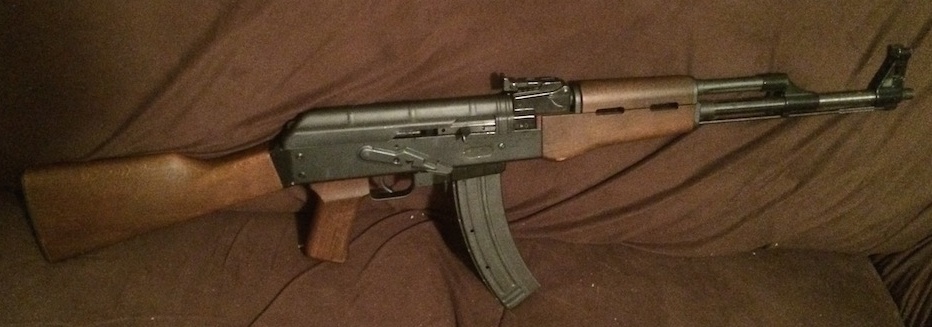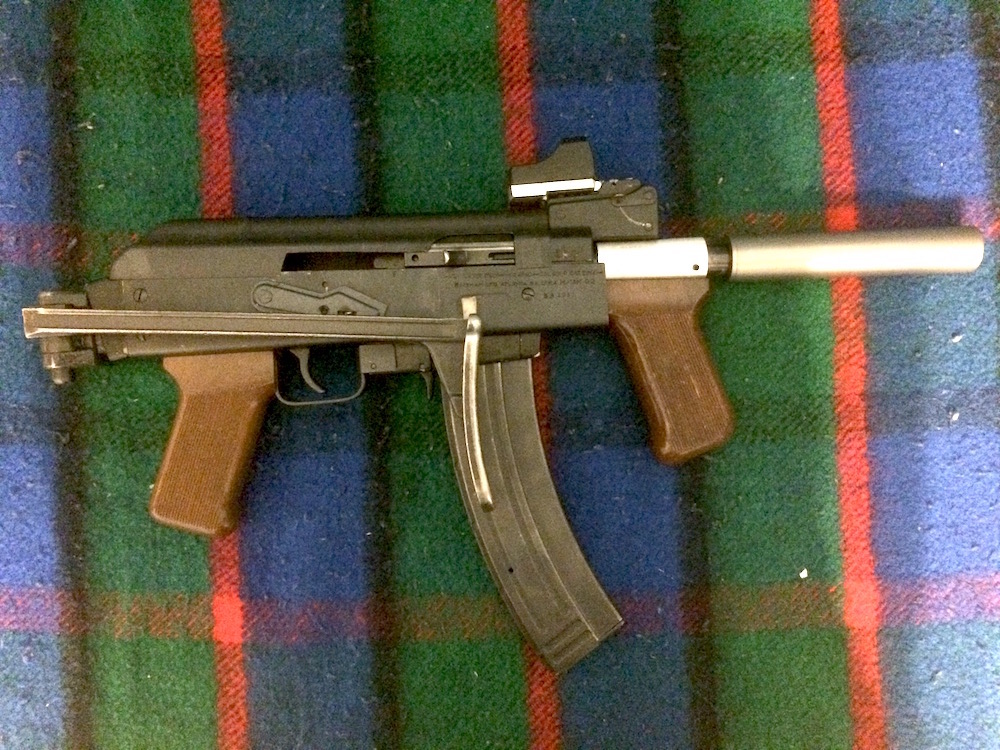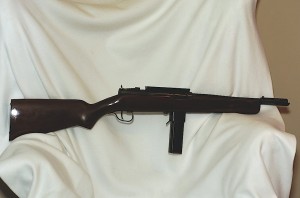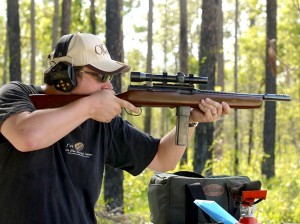Category: Machine Guns
Back in the early 80’s there was a beginning trend of making rimfire rifles look like the rifles that the worlds armed forces where using. One of the more successful companies at doing just that was Armi Jager of Italy.
They started with their AP-74 (in roughly 1974) that was a copy of the very popular M16 rifle used by the US military and others. The rifles where known as being well made and relatively reliable. they weren’t exact copies by any means, but they looked pretty similar, and had a fairly similar manual of arms with only slight differences in the safety and the magazine release.
The AP-74 proved to be very popular, and was followed a few years later by the AP-80, with the AP-80 being a scaled down copy of the kalashnikov AK47. The manual of arms is almost identical, and with the “large body” magazine in place, only the most observant onlooker would guess that the little gun is anything but a rifle caliber gun.
The AP-80 was imported by several groups into the US, with the earliest guns coming in under Bingham’s banner. There may have been another small importer after Bingham and before Mitchell, but the records are a bit fuzzy, so I’m not certain. Sometime after Bingham ceased importing the guns, Mitchell arms in California (I know, California?) began the import of the AP-80. There were subtle differences between the guns that can be noted fairly easily by the keen observer. The Mitchell guns had a much thicker dust cover over the action, with the front of the dust cover being secured to the receiver by rivets on either side of the “trunnion” for lack of a better term, while the Bingham guns had thinner list covers, and were secured at the front by wedging beneath a roll pin protruding from the trunnion beneath the rear sight.
After the AP-80 debuted, other rimfire clone guns followed from Armi Jager, including Galil copies, Famas copies, and a copy of the PPS-31.

I’m going to focus on the AP-80 for this article, for reasons that will be clear shortly.
Prior to the implementation of the machine gun ban in 1986, there where a number of AP-80’s registered and converted to select fire by enterprising individuals. SWD of Atlanta offered conversion kits, and the services, JD Farmer did conversions as well, but didn’t sell DIY kits. These two are probably the most commonly encountered conversions, but calling them common is a bit of a misnomer.
Both SWD and Farmer conversions used an automatic sear trip, along with lengthened selector lever throw. Most Farmer conversions had the selector stop ground off, while the SWD conversions often had the selector notched for the added travel.
SWD conversions consisted of the auto sear, auto sear spring, bolt anti-bounce weight, cut selector lever, bolt modified for the sear trip, and modified disconnector (so that Semi auto remained an option). The SWD DIY kit consisted of the auto-sear, spring and anti-bounce weight, with instructions on how to install the parts and make the needed cuts.
The Farmer conversions where a little more involved, using all of the things mentioned in the SWD conversion, the Farmer jobs (other than cutting the lever vs grinding the receiver) also lengthened the bolt stroke and added a booster spring to the main (hammer) spring to ensure more reliable ignition.
Today, finding one of these gems as a transferable is fairly rare, with probably less than 5 on the market at any given time. In looking just now, I could only find one for sale. Any of them are likely to need work to make them run right.
I purchased one last summer, and once I was finally able to bring it home from the dealer a few months ago, I began the process of working on it to produce a reliable gun. Mine was an SWD style conversion, though it seems it was likely done at the Bingham (importer of the gun) shop, as that’s who the the maker is listed as on the form 4.
I made a new firing pin, as the factory unit broke fairly quickly. It’s profile is different, and it uses a much thicker body and a shorter spring. I also made the tip slightly sharper to help with ignition.
The hammer spring was replaced with a much stronger unit. The recoil spring was replaced as well, and the recoil stroke lengthened about 1/2″. The dust cover had to be opened up as well for the increased stroke.
The bolt was polished and all of the nooks and crannies were cleaned out with an ultrasonic cleaner and brushes. the extractor was reshaped for improved grip.
Once I had done that work, the gun went from running about 50% to running about 95%
Then it was time to play, so I made an adapter block so that I could mount a VZ-58 stock, I chopped a parts kit barrel down to 5″ (it’s a machine-gun, so there are no barrel length requirements for legality) and threaded it 1/2″x28 tpi for attaching a standard rimfire suppressor. Since the forend would no longer work, I made an adapter so that I could mount the pistol grip from the parts kit as a forward K-grip.
I also made a mount for the red-dot sight so that I wouldn’t have to fab up a front sight. It uses the rear sight position and set screws to hold the red dot in place and supply gross elevation adjustment.
It looks a little funky, but it handles very very well, and it’s a ton of fun to shoot!

June 7, 2016 Tony 2 Comments
About a year and a half ago, I purchased another SMG, this one being an SWD M11/9mm. There are a lot of them around, and as a result, when I picked it up it was one of the cheaper SMG’s available on the market. According to some estimates there are as many as 37,000 of these little sheet metal guns in the registry. Considering the fact that the ATF says there are only about 175,000 transferable machine-guns total, they represent a large portion of the registered MG’s in the market.
It’s native caliber is 9mm, and it fires from an open bolt using 32 round magazines. I also managed to pick up an early suppressor for it, and the combination is fairly effective. Not quiet, but hearing safe.
But one of the real reasons I wanted the gun was the availability of the .22 conversion kit made by Lage manufacturing. With the kit, you can fire .22 ammo full auto, and I love shooting .22’s!
After having USMG do some custom work, the gun runs like a top with the .22 kit, and with the new shockwave Z-mags, it runs well in 9mm as well. Overall, it’s a very enjoyable little bullet hose.
I have added Lage grips, Mag release, Safety internals and slider, a side cocking upper, a red dot, and a custom made billet Aluminum stock.

March 17, 2016 Tony 0 Comments
Some friends and I shooting the Reising M50 SMG over the course of 2 range trips about a month apart.
October 10, 2013 Tony 0 Comments
When the Reising arrived about 2 months ago, as one might expect, I took it out and shot it. But even before my first range trip, I followed the advice of a fellow reising owner, and modified the firing pin to be inertia style in order to prevent breakage. It did alright the first outing, although it lived up to the poor reliability stereotype.
Each time out, it seemed to get progressively worse. In spite of cleaning the gun to spotless after every outing, it would have frequent jams. I ran through about a dozen different loads, hoping to find the one that would get me some reliability. Almost every jam was the same. The last round chambered would have a light primer strike, but didn’t fire. I surmised that my primers were too hard, and started looking for some federal primers to use. The reason I was looking at different loads was that I was assuming the hammer wasn’t being pushed fully rearward, thus allowing the light strikes from it’s sort of intermediary position.
Before I found any federal primers, my firing pin broke. Frustrated and somewhat disheartened, I ordered a modern and improved replacement from Keystone arms. While I was at it, I ordered a new set of springs.
After installing the unaltered firing pin and new springs, I went to the range, and proceeded to have a jam after 3 rounds. The jam was so bad that I packed the gun up and took it home. When disassembling the gun later that day, I looked and looked, and couldn’t find the reason for my jam. I eventually found a tiny fleck of metal stuck to the bolt, and picked it off. Now the bolt was moving freely again, so I decided to head back to the range. I didn’t expect much.
I took the ammo I had with me, a mix of the various batches I had tried when looking for a reliability load, and loaded up the mags. To my pleasant surprise, when I pulled the trigger, the whole mag went down range, just as I knew it should have been doing since I got it. I inserted the next magazine, and worked the action bar. Brrrrrrrrrrrrrrrrrap! Another successful mag dump! I loaded and dumped until I was completely out of ammo. In 400+ rounds, I only had one stoppage, and that was due to a magazine that I knew had issues. I discovered that all of my loads worked just fine, and with good magazines, the gun would run like a watch!
In the future, when I know I should do some simple maintenance, like changing out springs and a firing pin, I hope I’ll remember the lesson learned here, and just do it from the get go.
If you have a Reising, I highly recommend the Ken Christie firing pin and replacement springs, the difference in my gun was like night and day!
August 12, 2013 Tony 4 Comments
I’ve wanted a machine gun since I was about 5 years old. For whatever reason, the timing and money never quite lined up for me to buy one until fairly recently. I spent a lot of time figuring out what I wanted, and trying to decide what I could afford. Eventually, I decided I wanted a Reising SMG. They don’t have the best reputation for reliability, but I tinker anyways, so I figured I’d take the chance on one. It took a little time to find the right deal, but I started the process of buying a Reising model 50 last September.
(For those of you who don’t know, NFA weapons, such as machine-guns, silencers, sawed off shotguns and other related things require a lengthy background check and a transfer tax to be paid. The process isn’t terribly difficult, but it is time consuming)
After many long months of waiting, my wife called me at the office one day in June to tell me that she had just signed for a package for me (Being C&R eligible, I had the gun transfer directly to me on my 03 FFL). Of course, I cut out of the office early and rushed home.
My wife stood there with me while I unwrapped layer after layer of bubble wrap, getting closer and closer to the object of desire.
Finally, I managed to get through all the layers, and pulled out my very own machine gun.

As things worked out, while this wasn’t my first NFA purchase, it is the first NFA device in hand. My other toys will be trickling in later in the summer or sometime in the fall (even though some of them were paid for months before the Reising…)
I had been doing my homework for some time on the gun, and within minutes of it’s arrival, I made some minor modifications to help with it’s long term reliability, most importantly, modifying the firing pin to act as an inertia pin.
The scope rail attached to the gun wasn’t something I was particularly excited about, but it made it more affordable, and I wouldn’t have to worry about the originality of the gun, and could treat it as a shooter. Since the gun had a rail, I decided I might as well use it. Looking through my collection of random optics for an appropriate red dot sight, I noticed a vintage low powered Weaver scope. I hadn’t thought of putting a scope on an SMG before, but heck this thing is more of a select fire carbine anyways… so I mounted the old Weaver K-2.5 micro-trac, just to see what it would look like.

It actually looked pretty good to my eyes, so I put it in the safe, and the next morning reluctantly left town for 4 days on a trip that had been planned months in advance. (I seriously contemplated bringing the gun with me on the trip and looking for a range while away, but the wife talked me out of it)
When I got back, I loaded the range bag with some ammo, various cleaning goodies, and my 3 magazines. One factory mag, and one Christie’s products mag came with the gun, and while I had been waiting, I had picked up another Christie mag. It was finally time to shoot.
This wouldn’t be my first time shooting a machine gun, but it was the first time shooting my own machine gun, and I was as excited as a kid on christmas morning. Despite that, I resisted the temptation to let loose right away, and fired the first magazine in semi auto to make sure everything was working as expected (firing pin) and to get the scope adjusted. I was impressed by the accuracy in semi auto mode; freehand shooting was producing groups with every hole touching at 25 yards.

I was still concerned that the scope would make target acquisition more difficult than a red dot might, and that it would be harder to stay on target, so I brought a spare red dot with me, just in case I might need it. The range went cold after the first magazine, and we put up some fresh targets. After what must have been a few minutes, even though it felt like a half a day, the range went hot again, and it was time to push the selector forward, and see what would happen.
Needless to say, I was very pleased to be shooting my very own machine gun. I was even more pleased that I could stay on target very well with the scope, and target aquisition was better than expected. I wouldn’t need that red dot after all! After reading lots of horror stories about the reliability of the Reisings, I was relieved that it was running pretty well.
I discovered quickly that the magazines, you know, the ones that cost an arm and a half a leg? Well, they are quite finicky. The factory mag would feed the Lee 200 grain RF bullet, along with everything else I tried, but neither of the Christie mags would even think about feeding the RF. As a matter of fact, one of the Christie mags wouldn’t feed anything at all. I’ve since fixed that, and it’s as reliable as the other mags after some tweaking with pliers, a file and some sandpaper. The other Christie mag would feed RN profile bullets and SWC profile bullets fine. That suits me alright, as I cast a few styles of SWC, and generally prefer the profile anyways due to the nice clean holes they cut in the targets.
After my wife shot the gun, and between the two of us, we expended the rest of the ammo we brought with us (with varying degrees of functional reliability) we picked up our brass, packed up the car and headed home, where I spent at least an hour thoroughly cleaning the Reising. After getting it nice and clean, I nestled it back in the safe with several of the other C&R guns that I’ve had sent to me on my collectors license. I appreciated for a moment the irony that of the 4 guns I’ve ever bought using my C&R license, 3 of them are single shot boy’s rifles, and one is a machine gun.
After spending thousands of dollars on something like a machine gun, it’s easy to wonder if you made the right decision. After the first day shooting the Reising, there was no doubt in my mind that I had. At the moment, I’m saving up for my next MG purchase.
More to come on shooting the Reising and load development for reliability and accuracy.
A teaser of what the gun can do at 25 yards with a mag dump:

And at the same rang eon Semi-Auto:

July 31, 2013 Tony 2 Comments






